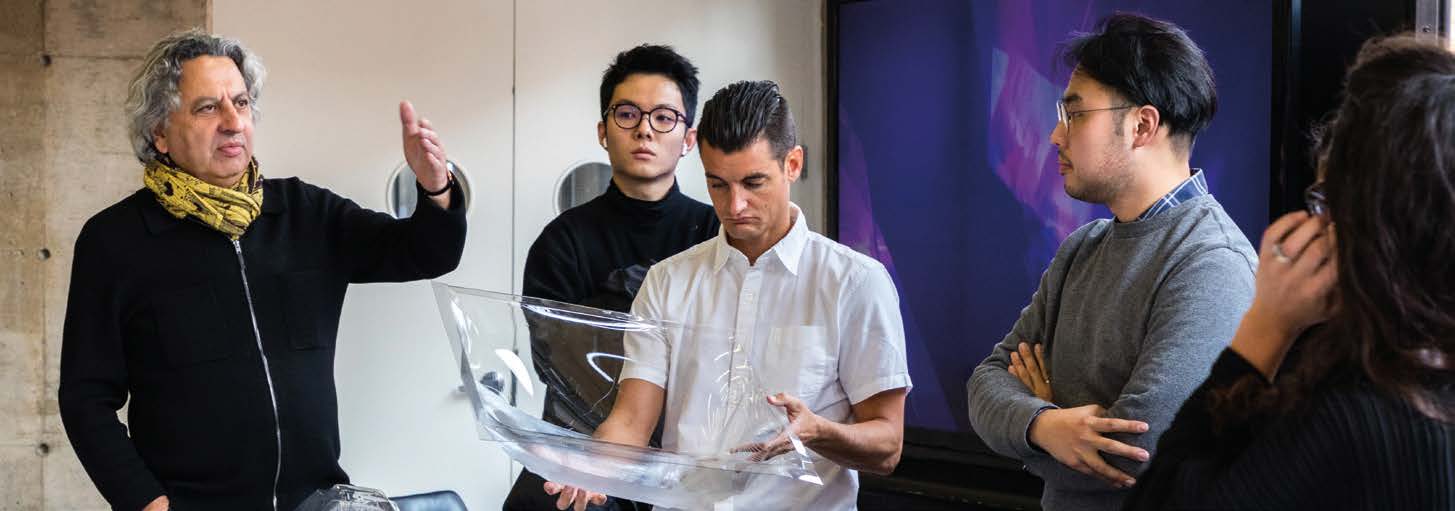2017-2018 Annual Report: Overview by Dean Mostafavi

Dean Mohsen Mostafavi (far left) with John May MArch ’02 (center) and review participants during the final review for the fall 2017 course “Experiments in Computer Graphics.”
Dear Alumni and Friends,
With the passing of each academic year, our community has the opportunity to reflect on our many accomplishments and to anticipate and imagine future achievements. The previous fiscal year saw some significant milestones for the GSD, including the energizing and successful final year of our Grounded Visionaries campaign, the University’s capital campaign, and some important leadership appointments. As always, the talent, dedication, and optimism of our community this year remind us why we engage in our project and what we can accomplish when we listen to, collaborate with, and encourage each other.
This Annual Report represents a synthesis of everything we have pursued and accomplished over the past fiscal year and how the GSD—through its pedagogy, collaborations, and community—leads the conversation about the future of design.
As we continue to investigate the question of how design can respond to urgent challenges and opportunities in cities, nations, and ecologies around the world, design research and its translation to applied innovation remain the cornerstone of this effort. In the pages ahead, you will read about the Harvard Center for Green Buildings and Cities, which celebrated the commissioning of its much anticipated “HouseZero” project last April (see page 27). With generous support from the John S. and James L. Knight Foundation, we also launched the “Future of the American City” initiative last spring, announcing our inaugural research projects in the cities of Miami and Miami Beach. I hope you will also visit the Research (see page 26) and Philanthropic Support (see page 44) sections of this Report to learn more about the many exciting opportunities we are pursuing. Some of the most groundbreaking dialogue and progress at the GSD take place in our courses and studios. Each of our departments has the opportunity to bring leading practitioners to the GSD and to engage students in site visits around the world, ranging from Marina Tabassum’s architectural exploration in Bangladesh to Eelco Hooftman and Bridget Baines’s look at Mount Desert Island in Maine, not to mention important investigations of our home city of Cambridge and neighboring areas. Please take a moment to learn about these and other department highlights on pages 13, 17, and 18.
The opportunity to not only gather but also share, celebrate, and reflect on the richness of our work is significant, and I am always impressed by how creatively and powerfully we illustrate our pursuits to the rest of the world. We invite and hear from many enormously talented speakers, whose perspectives enrich our learning and our community (see pages 33–37). Special moments last year included an October symposium in celebration of the 100th birthday of our friend and GSD alumnus I. M. Pei MArch ’46, as well as our second Black in Design Conference, organized by students in the GSD’s African American Student Union. In celebrating a generous gift from Ronald M. Druker LF ’76, we named our main exhibition space the Druker Design Gallery. In January, K.Michael Hays and Andrew Holder filled this Gallery with its inaugural exhibition, “Inscriptions: Architecture Before Speech,” which brought together a rich diversity of work from the GSD community and beyond Gund Hall. The many other fascinating and rewarding exhibitions and publications produced this past year are listed on pages 38–39 and 42–43.
As we recognized the change in leadership from Harvard University President Drew Gilpin Faust to President Lawrence S. Bacow in summer 2018, we also celebrated a leadership change of our own: the appointment of Mark Lee MArch ’95 as chair of our Department of Architecture. We also thanked Beth Kramer, associate dean for development and alumni relations, for her years of dedication to the School and for leading us through a successful capital campaign. The Development and Alumni Relations Office, along with the many faculty and staff who assisted in the work of the Campaign, made this final year a powerful one, and I hope you will read more about their work and impact on pages 44–47.
As we look back in this Annual Report at what we have accomplished, we are reminded of our potential, especially at this pivotal moment for the design fields and for the GSD. I hope it inspires you to engage with the School in the coming year and to remain committed to empowering the next generation of design leaders and innovators.
Best,
Mohsen Mostafavi
Dean and Alexander and Victoria Wiley Professor of Design


